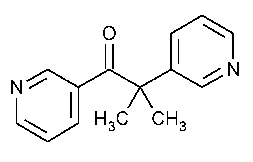Metyrapone
1-Propanone,2-methyl-1,2-di-3-pyridinyl-.
2-Methyl-1,2-di-3-pyridyl-1-propanone [54-36-4].
»Metyrapone contains not less than 98.0percent and not more than 102.0percent of C14H14N2O,calculated on the dried basis.
Packaging and storage—
Preserve in tight containers,protected from heat and light.
Identification—
A:
Infrared Absorption á197Mñ.
Loss on drying á731ñ—
Dry it in vacuum at room temperature for 6hours:it loses not more than 0.5%of its weight.
Residue on ignition á281ñ:
not more than 0.1%.
Heavy metals,Method IIá231ñ:
0.001%.
Chromatographic purity—
Standard solutions—
Dissolve USP Metyrapone RSin methanol,and mix to obtain a solution having a known concentration of 0.2mg per mL.Dilute quantitatively with methanol to obtain Standard solution A,containing 40µg of the Reference Standard per mL,and Standard solution B,containing 20µg of the Reference Standard per mL.
Test solution—
Dissolve an accurately weighed quantity of Metyrapone in methanol to obtain a solution containing 20mg per mL.
Procedure—
Apply separately 5µLof the Test solutionand 5µLof each Standard solutionto a suitable thin-layer chromatographic plate (see Chromatography á621ñ)coated with a 0.25-mm layer of chromatographic silica gel mixture.Position the plate in a chromatographic chamber,and develop the chromatograms in a solvent system consisting of a mixture of chloroform and methanol (48:3)until the solvent front has moved about three-fourths of the length of the plate.Remove the plate from the developing chamber,mark the solvent front,and dry under a current of nitrogen for about 10minutes.Position the dried plate once again in the same chromatographic chamber,and again develop the chromatograms,until the solvent front has moved about three-fourths of the length of the plate.Remove the plate from the developing chamber,mark the solvent front,and dry under a current of warm air for about 15minutes.Examine the plate under short-wavelength UVlight,and compare the intensities of any secondary spots observed in the chromatogram of the Test solutionwith those of the principal spots in the chromatograms of the Standard solutions:no secondary spot from the chromatogram of the Test solutionis larger or more intense than the principal spot obtained from Standard solution A(0.2%),and the sum of the intensities of the secondary spots obtained from the Test solutioncorresponds to not more than 1.0%.
Assay—
Transfer about 50mg of Metyrapone,accurately weighed,to a 100-mLvolumetric flask.Dissolve in 1Nsulfuric acid,dilute with the same solvent to volume,and mix.Pipet 2mLof this solution into a 100-mLvolumetric flask,add 1Nsulfuric acid to volume,and mix.Dissolve an accurately weighed quantity of USP Metyrapone RSin 1Nsulfuric acid,and dilute quantitatively and stepwise with 1Nsulfuric acid to obtain a Standard solution having a known concentration of about 10µg per mL.Concomitantly determine the absorbances of both solutions in 1-cm cells at the wavelength of maximum absorbance at about 260nm,with a suitable spectrophotometer,using 1Nsulfuric acid as the blank.Calculate the quantity,in mg,of C14H14N2Oin the portion of Metyrapone taken by the formula:
5C(AU/AS),
in which Cis the concentration,in µg per mL,of USP Metyrapone RSin the Standard solution,and AUand ASare the absorbances of the solution of Metyrapone and the Standard solution,respectively.
Auxiliary Information—
Staff Liaison:Andrzej Wilk,Ph.D.,Senior Scientific Associate
Expert Committee:(RMI)Radiopharmaceuticals and Medical Imaging Agents
USP28–NF23Page 1288
Phone Number:1-301-816-8305
